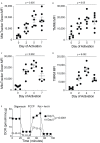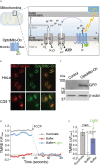Optical Control of CD8+ T Cell Metabolism and Effector Functions
- PMID: 34149701
- PMCID: PMC8209468
- DOI: 10.3389/fimmu.2021.666231
Optical Control of CD8+ T Cell Metabolism and Effector Functions
Abstract
Although cancer immunotherapy is effective against hematological malignancies, it is less effective against solid tumors due in part to significant metabolic challenges present in the tumor microenvironment (TME), where infiltrated CD8+ T cells face fierce competition with cancer cells for limited nutrients. Strong metabolic suppression in the TME is often associated with impaired T cell recruitment to the tumor site and hyporesponsive effector function via T cell exhaustion. Increasing evidence suggests that mitochondria play a key role in CD8+ T cell activation, effector function, and persistence in tumors. In this study, we showed that there was an increase in overall mitochondrial function, including mitochondrial mass and membrane potential, during both mouse and human CD8+ T cell activation. CD8+ T cell mitochondrial membrane potential was closely correlated with granzyme B and IFN-γ production, demonstrating the significance of mitochondria in effector T cell function. Additionally, activated CD8+ T cells that migrate on ICAM-1 and CXCL12 consumed significantly more oxygen than stationary CD8+ T cells. Inhibition of mitochondrial respiration decreased the velocity of CD8+ T cell migration, indicating the importance of mitochondrial metabolism in CD8+ T cell migration. Remote optical stimulation of CD8+ T cells that express our newly developed "OptoMito-On" successfully enhanced mitochondrial ATP production and improved overall CD8+ T cell migration and effector function. Our study provides new insight into the effect of the mitochondrial membrane potential on CD8+ T cell effector function and demonstrates the development of a novel optogenetic technique to remotely control T cell metabolism and effector function at the target tumor site with outstanding specificity and temporospatial resolution.
Keywords: T cell migration; cancer immunotherapy; effector T cell; metabolism; optogenetics.
Copyright © 2021 Amitrano, Berry, Lim, Kim, Waugh, Wojtovich and Kim.
Conflict of interest statement
The authors declare that the research was conducted in the absence of any commercial or financial relationships that could be construed as a potential conflict of interest.
Figures







Similar articles
-
Metabolic Challenges in Anticancer CD8 T Cell Functions.Immune Netw. 2023 Jan 27;23(1):e9. doi: 10.4110/in.2023.23.e9. eCollection 2023 Feb. Immune Netw. 2023. PMID: 36911801 Free PMC article. Review.
-
Reversing tumor immune suppression with intratumoral IL-12: activation of tumor-associated T effector/memory cells, induction of T suppressor apoptosis, and infiltration of CD8+ T effectors.J Immunol. 2006 Nov 15;177(10):6962-73. doi: 10.4049/jimmunol.177.10.6962. J Immunol. 2006. PMID: 17082611
-
Regulation of CD8+ T cells by lipid metabolism in cancer progression.Cell Mol Immunol. 2024 Nov;21(11):1215-1230. doi: 10.1038/s41423-024-01224-z. Epub 2024 Oct 14. Cell Mol Immunol. 2024. PMID: 39402302 Free PMC article. Review.
-
Early effector maturation of naïve human CD8+ T cells requires mitochondrial biogenesis.Eur J Immunol. 2018 Oct;48(10):1632-1643. doi: 10.1002/eji.201747443. Epub 2018 Aug 7. Eur J Immunol. 2018. PMID: 30028501
-
Mitochondrial Morphological and Functional Reprogramming Following CD137 (4-1BB) Costimulation.Cancer Immunol Res. 2018 Jul;6(7):798-811. doi: 10.1158/2326-6066.CIR-17-0767. Epub 2018 Apr 20. Cancer Immunol Res. 2018. PMID: 29678874
Cited by
-
ERK Inhibition Promotes Engraftment of Allografts by Reprogramming T-Cell Metabolism.Adv Sci (Weinh). 2023 Jun;10(16):e2206768. doi: 10.1002/advs.202206768. Epub 2023 Apr 4. Adv Sci (Weinh). 2023. PMID: 37013935 Free PMC article.
-
Influences of metabolism and lipid homeostasis on regulatory vs. conventional T cells and implications for autoimmunity.Front Immunol. 2025 Jul 7;16:1613230. doi: 10.3389/fimmu.2025.1613230. eCollection 2025. Front Immunol. 2025. PMID: 40692789 Free PMC article. Review.
-
Deleting the mitochondrial respiration negative regulator MCJ enhances the efficacy of CD8+ T cell adoptive therapies in pre-clinical studies.Nat Commun. 2024 May 24;15(1):4444. doi: 10.1038/s41467-024-48653-y. Nat Commun. 2024. PMID: 38789421 Free PMC article.
-
Immune Checkpoint Proteins, Metabolism and Adhesion Molecules: Overlooked Determinants of CAR T-Cell Migration?Cells. 2022 Jun 6;11(11):1854. doi: 10.3390/cells11111854. Cells. 2022. PMID: 35681548 Free PMC article. Review.
-
Human immunodeficiency virus and antiretroviral therapy-mediated immune cell metabolic dysregulation in children born to HIV-infected women: potential clinical implications.Front Immunol. 2023 Jun 7;14:1182217. doi: 10.3389/fimmu.2023.1182217. eCollection 2023. Front Immunol. 2023. PMID: 37350953 Free PMC article. Review.
References
-
- Eshhar Z, Waks T, Gross G, Schindler DG. Specific Activation and Targeting of Cytotoxic Lymphocytes Through Chimeric Single Chains Consisting of Antibody-Binding Domains and the Gamma or Zeta Subunits of the Immunoglobulin and T-cell Receptors. Proc Natl Acad Sci (1993) 90:720–4. 10.1073/pnas.90.2.720 - DOI - PMC - PubMed
Publication types
MeSH terms
Substances
Grants and funding
LinkOut - more resources
Full Text Sources
Research Materials
Miscellaneous

